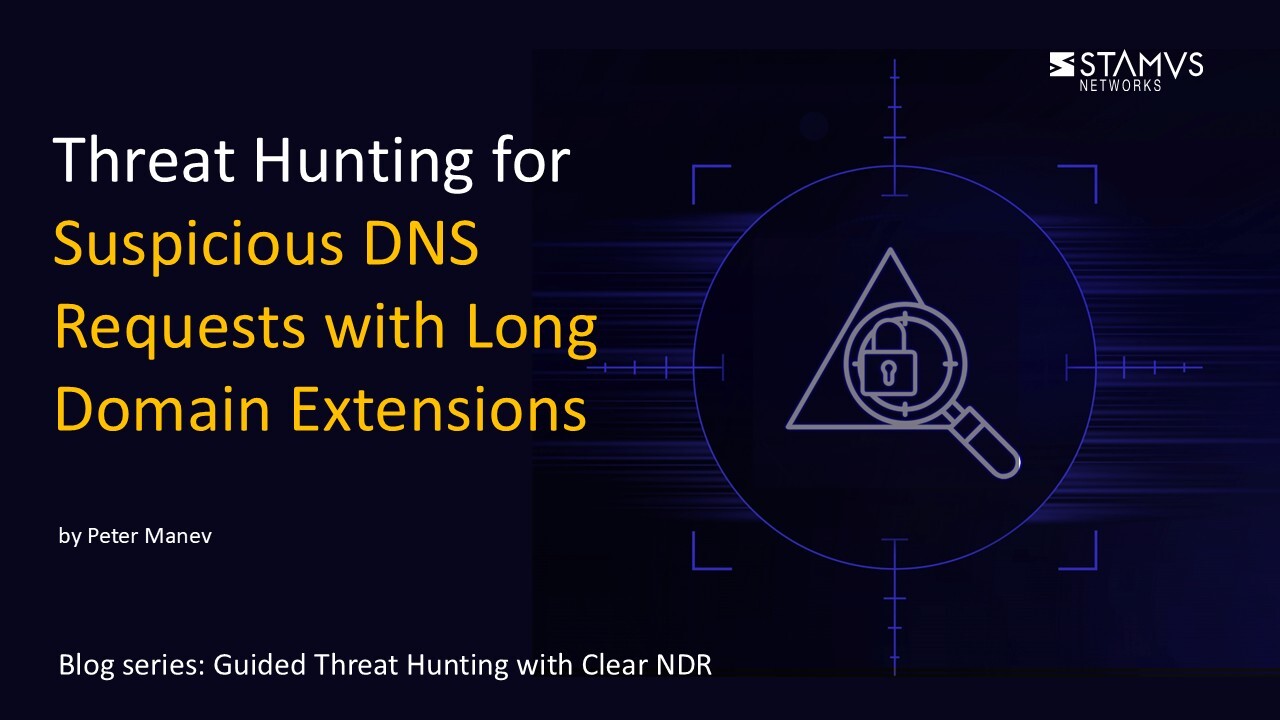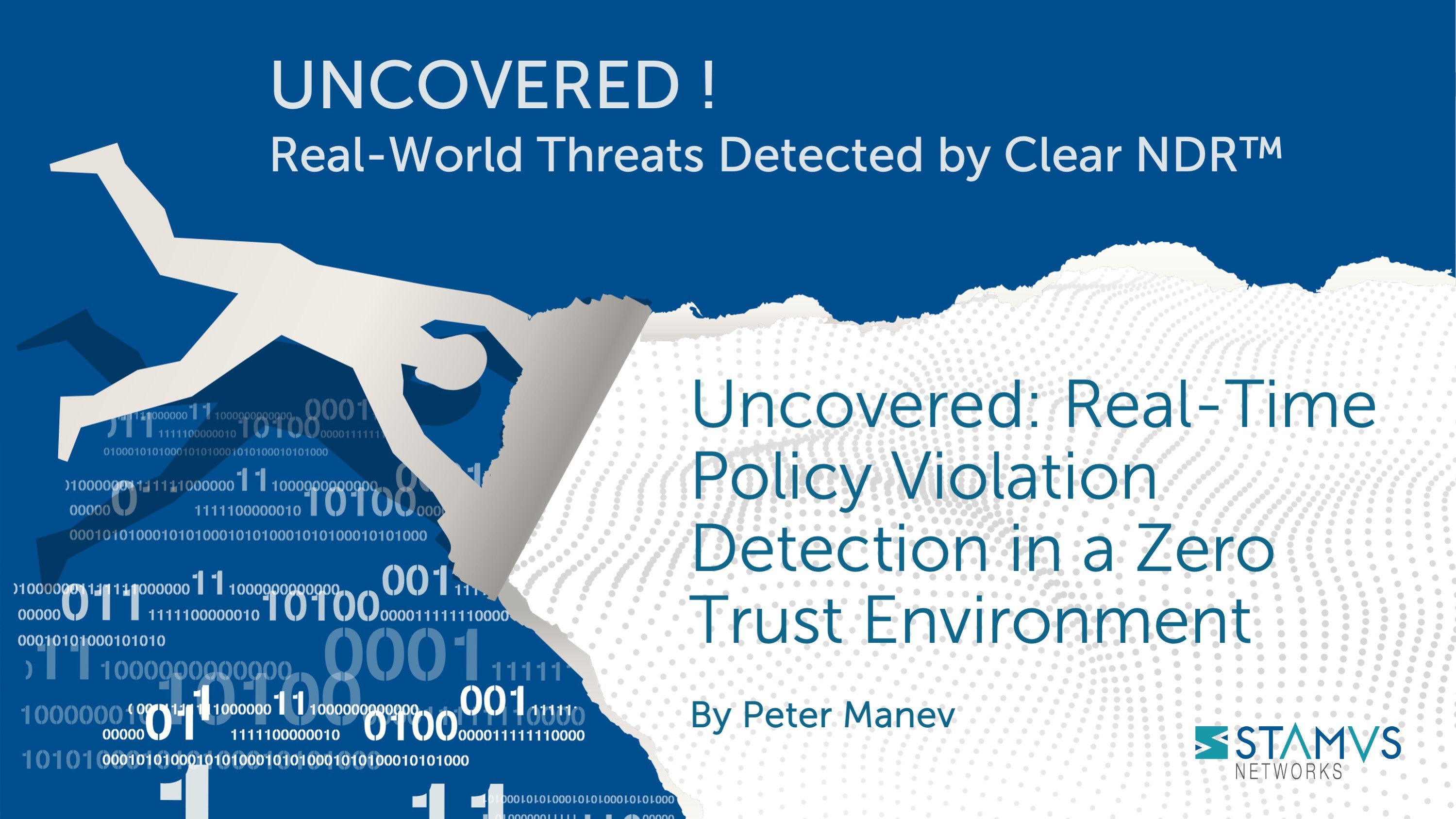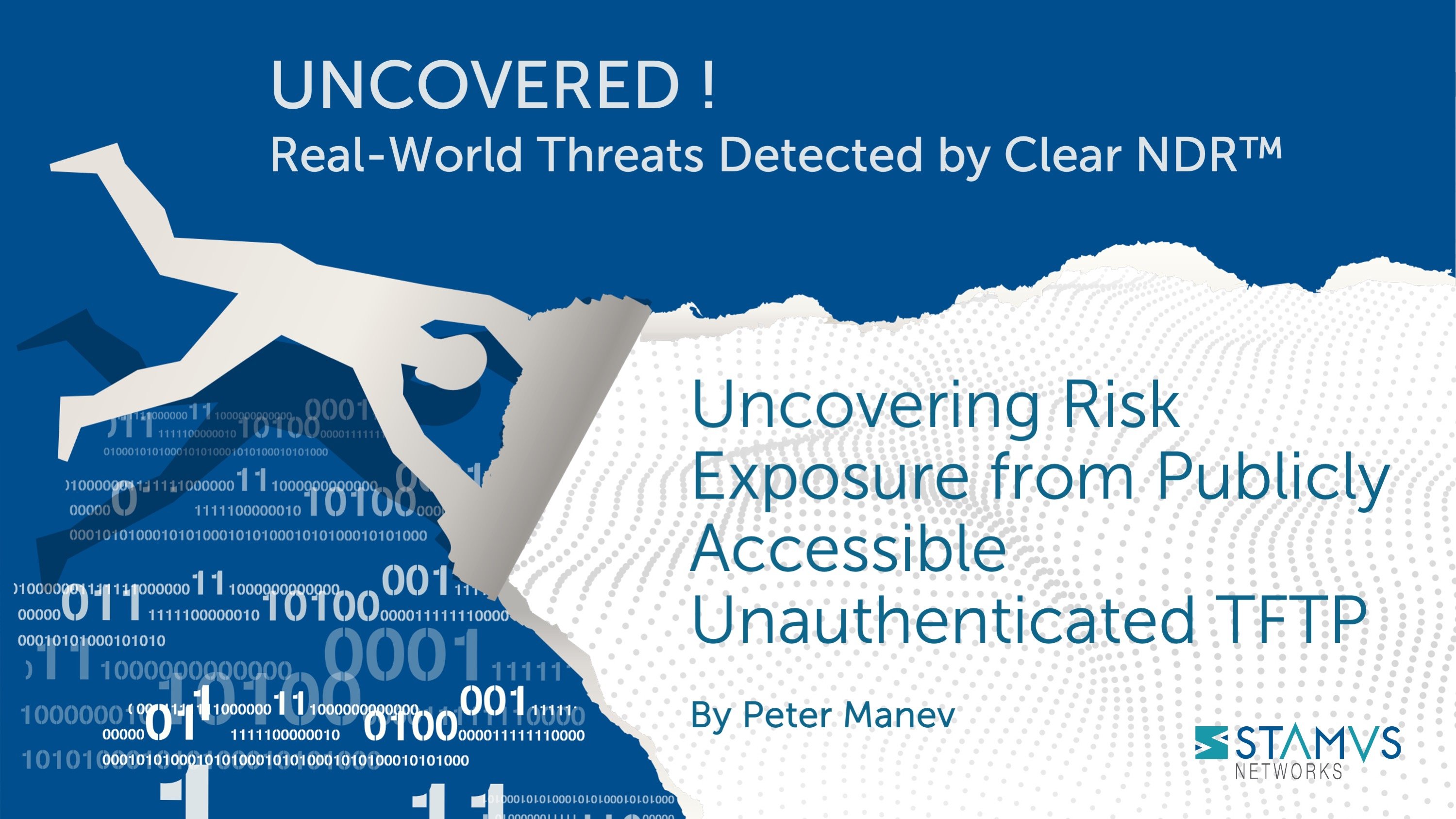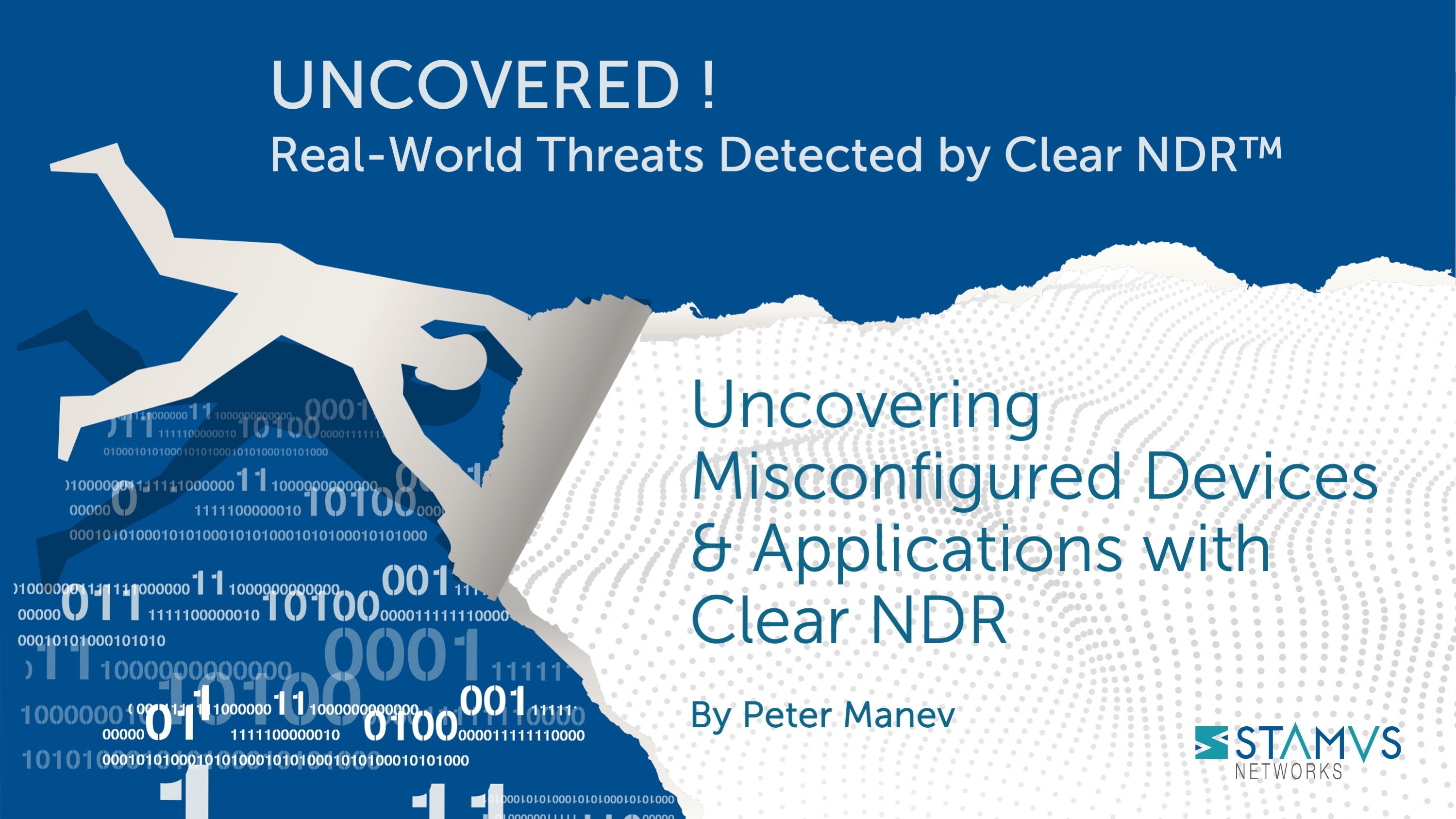When you see a domain request from a user/client to a non-local or otherwise unfamiliar or suspicious domain, it is worth taking a closer look. These types of requests could possibly be normal and unharmful, but they could also signal trouble for your organization. Long domain DNS requests could indicate the presence of a malware actor. If not malware, it could lead to the discovery of a policy violation or some other type of unusual, anomalous, or suspicious behavior. It is important to investigate these types of DNS requests in order to determine their origin and figure out if they pose a risk to your organization.
To find this kind of activity, a security team can use Clear NDR’s Enriched Hunting Interface to deploy one of over 100 guided hunting filters to simplify the discovery, investigation, and classification of shorter domain DNS requests on their network.
Clear NDR automatically detects and identifies threats on the network, and presents security teams with incident timelines and extensive context for each threat. Many organizations take advantage of advanced Clear NDR features and take an even more proactive approach to their defenses. When this is the case, they might task a security analyst with hunting for specific threat types, anomalous activity, or suspicious behaviors. To do this, they can use the Stamus Enriched Hunting Interface.
This interface provides security practitioners with over 100 ready-to-use guided threat hunting filters, including various filters for policy violations, that they can use to investigate, classify, escalate, and automate vast amounts of event data, alerts, and contextual metadata. For a more detailed look at the Enriched Hunting Interface, read the blog article titled, “Introduction to Guided Threat Hunting”.
What are long domain DNS requests?
A DNS request (or query) is a request for information sent from the user (the DNS client) to a DNS server. When a DNS request is sent, it is typically the client asking the server to provide the IP address associated with the given domain name. This is a fairly standard process as it happens every time a user attempts to access a new domain.
Long domain extensions are less common than typical short TLDs (such as .com or .org). Malware actors are known to use long domain extensions for malicious purposes, so investigating any suspicious DNS requests with long domain extensions is important to keep your organization’s network secure. While a long domain extension doesn’t always indicate the presence of a malware actor, it could lead to the discovery of a policy violation or other unapproved user activity.
By looking at all DNS requests with long domain extensions and then filtering them to identify cases that are potentially suspicious, we can highlight those instances that require further investigation.
Identifying long domain DNS requests with Clear NDR
Clear NDR does most of the work for you. With Declarations of Compromise™, it definitively identifies serious and imminent threats. However, no system can automatically detect everything. That’s why Clear NDR logs every possible indicator of compromise – otherwise known as “alerts” – in addition to sightings of previously unseen communications and corresponding protocol and flow logs. These alerts, including the corresponding enrichment and metadata, can be used to create a trail of evidence in an incident investigation. Additionally – as seen in this series – they can also be used to perform a guided hunt for specific threat types or other unwanted activity.
So let’s take a look at the current alerts on our system:
In the past 24 hours, we have had about 600K alert events which have triggered millions of results – including protocol, flow, and file transaction logs as well as Host Insights for over 16,200 network endpoints and hosts.
The hunt for long domain DNS requests using Clear NDR
To begin this hunt, we first have to select the relevant filter from the drop down list. Since there are over 100 guided hunting filters, we need to narrow the list down to find the filter we want.
To do this, we can search for the keyword “long” and then select the needed filter. In this example, the filter we want is titled “Hunt: Longer domain dns requests”.
Selecting this filter narrows our results from 600 thousand alert events and their corresponding protocol, flow, and file transaction logs down to only 2 in the selected timeline. This gives us an excellent starting point to work from.
It is important to note that Clear NDREnriched Hunting also provides additional organization-specific context. Users can filter for queries from various departments or user groups within the organization, allowing them to hyper-focus on specific areas without having to aggregate events or organize IP addresses to find specific users or departments. For example:
This organizational context is very useful and discloses very interesting results in terms of the clear text downloads.
As part of one of many enrichment processes, Clear NDR automatically breaks down any http/dns/tls domains within those network protocol records into its subforms - Domain, TLD, Host, and Domain without TLD.
There are several potential next steps we could take in this investigation, but I would like to take a closer look at the endpoints involved and see if any users that are seen there are still logged in. To get there, we need to see a list of all the hosts in order to know the full scope of what we are dealing with.
Knowing which clients and hosts are offenders and seeing additional information about the offense is important to get the full picture of this hunt. Specifically, we need to see which services are running on the offender’s host.
To do this, we can use Host Insights - a very powerful feature included with Clear NDR. Host Insights tracks over 60 security-related network transactions and communication attributes of a host. This provides a single place to view many aspects of the network activity relative to a given host, such as network services, users, or TLS fingerprinting forensic evidence.
We can click the “Hosts” tab on the left hand side panel and be transferred from the actual events logs to the Host Insights screen.
This filters our 600 thousand alert events and their corresponding protocol, flow, and file transaction logs down to only 1 event taking place on 2 hosts. One of these hosts is our Domain Controller, which makes sense as it serves as a DNS server. On the other host however, we see a user logged in. This is very valuable information to figure out the scope of the investigation. From here, investigating this host to get a better look at their activity is relatively simple.
This event alone is suspicious enough – as it is coming from regular clients . This leaves a few more questions. Why is this happening and what else in the network has used it or attempted to use it in the past?
Evidence for Incident Response
With just a few clicks, we are able to view two important sets of evidence:
- The associated network protocol transactions and flow logs
- Host Insights - a single screen for reviewing 60+ network activity attributes collected for every host
The generated events are already enriched by SSP to include important metadata like DNS records, TLS protocol data containing certificate names, fingerprint JA3/JA3S, connection flow sizes, http user agent, http host, request body, status codes, file transaction info, and more.
Expanding the actual event details in the Alerts tab gives us those details and the related network protocol and flow transaction logs. Based on the extra TLS, DNS, protocol, and flow transactions information that can be present including DNS request/reply, TLS SNI, Fingerprint, Issuer, JA3/JA3S, and the flow length and duration, it is obvious that those communications and transactions did in fact happen from the end point.
With this information, we have located both the users and stations involved. We also have an IoC and details on where the file has been seen in the network.
Now, we need to identify what part of that offending infrastructure we first saw on the network and where it came from. In other words, we need to locate the offending services. To do that, we can use the “Sightings” feature in Stamus Security Platform. This feature gives us the ability to pinpoint the first time a piece of metadata (such as domain, TLS certificate, HTTP host/user agent/server, JA3, JA3S, file checksum, filename etc) has been seen in the enterprise.
All we have to do is keep the same filter on, but switch off all “Alerts” and leave “Sightings” switched on.
That reveals more helpful info as the only place we have seen similar IoCs is from the same host. However, there are other dns name variations:
Security analysts can use any piece of metadata to create simple or complex filters for things like wildcarding, negation, or inclusion. You can even include multiple fields for fast drill down capabilities. All domains, TLS SNI, IP addresses, HTTP hosts, and more can easily be checked with an external threat intelligence provider such as Virus Total.
Armed with the above information and evidence, a threat hunter has enough information and IoCs to generate an Incident Response ticket.
However, there are still two tasks left to complete:
- 1. We do not want to have to repeat this exact same process again in the future, so we need to set up classification and auto-escalation for future occurrences.
- 2. If anything like this has happened before, we want it to be found and escalated with all the associated evidence - all based on historical data.
Classification
In order to streamline the event review/triage process in the future, an experienced analyst can choose to tag/classify the events associated with this filter By doing so, Clear NDR will tag future events that match the filter criteria as “relevant” or “informational,” depending upon the analyst’s selection. These tags can be used to automate event review/triage and make it easier for a less-experienced analyst to identify events that are relevant for manual review.
To do so, the analyst selects the Tag option from the Policy Action menu on the right hand side menu. This action will cause SSP to insert a tag into each event record as shown below:
This allows the analyst to easily filter out or search for them in any SIEM (Chronicle, Splunk, Elasticsearch, etc) or data lake using that tag.
It also allows for easy filtering out of those events in the Stamus Enriched Hunting GUI by switching to “relevant” only classified events.
Escalation and Automation of this Hunt
To set up an automation which causes Clear NDRto escalate past and future occurrences, we can create a Declaration of Compromise (DoC) event from the Policy Actions drop down menu on the right hand side panel in the Stamus Enriched Hunting Interface.
The next step is to add some explanation about the type of threat. This also gives us a chance to provide informational context and helps convey knowledge to colleagues.
Select options to generate events from historical data and generate Webhook notifications. We also use a little trick here to give us non-DNS services - TLS/HTTPS services observed on the network from the same offender:
Just like that, the hunt and all related activities are complete. Any past or future generated events from that automation will then be further auto-classified and escalated to the desired response process - via SOAR playbook, chat notification, or incident response ticket.
Our DoC escalation gives us exactly that. With a timeline of hosts involved and their involved offenders with past occurrences.
From now on any such threat occurrences will be auto escalated, Incident Response tickets opened and SoC channel notifications sent.
Conclusion
The post-hunt activities completed in this example are just the tip of the iceberg when it comes to the automation and escalation capabilities of Clear NDR. To learn more about these features and how to implement them, read our article titled “After the Hunt”.
To learn more about Network Detection and Response (NDR) from Stamus Networks and see the enriched hunting interface for yourself, click the button below and schedule a live demo.







